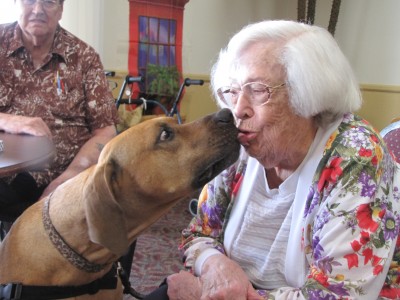A therapy dog is a dog with an exceptional temperament who is used to provide affection and comfort to people in a variety of settings such as hospitals, nursing homes, retirement communities and schools or programs for children with learning, developmental and physical disabilities. They are also used in highly stressful situations such as disaster relief.
Wikipedia provides a concise and accurate discussion of therapy dogs:
Therapy dogs come in all sizes and breeds. The most important characteristic of a therapy dog is its temperament. A good therapy dog must be friendly, patient, confident, gentle, and at ease in all situations. Therapy dogs must enjoy human contact and be content to be petted and handled, sometimes clumsily.
A therapy dog’s primary job is to allow unfamiliar people to make physical contact with it and to enjoy that contact. Children in particular enjoy hugging animals; adults usually enjoy simply petting the dog. The dog might need to be lifted onto, or climb onto, an individual’s lap or bed and sit or lie comfortably there. Many dogs contribute to the visiting experience by performing small tricks for their audience or by playing carefully structured games.
While we might think of ‘pet therapy’ as a modern concept, it has a very long history. Reports suggest that pet therapy was initially used in a mental health facility in the 1700s and then re-emerged in the treatment of military veteren’s during and after World War II. There are many anecdotal and scientific reports that document the value of contact with pets for improving physical and psychological symptoms.
There are many organizations that train and certify Therapy Dogs. The AKC has partnered with many of these organizations to acknowledge the contributions of Therapy Dogs and now offers a Therapy Dog Title (THD).
For more information about Therapy Dogs visit the AKC website
http://www.akc.org/akctherapydog/
For stories about Kanzu’s therapy dog adventures Click Here

